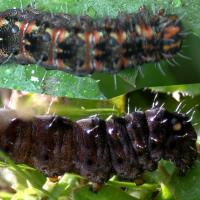Diagnosing pasture day moth damage
The caterpillar of the pasture day moth (Apina callisto) feeds on broadleaf weeds and crops, but is rarely a pest.
What to look for
- Chewing damage to seedling crops by large caterpillars that remain on the plant during the day.
Plant
- Dark brown to black caterpillar up to 60mm long with two distinct yellow spots near the posterior end.
The large adult moth is brown with yellow markings on the wings and orange rings around the body. It flies in autumn and by day as the
name implies.
Plant
Where did it come from?
- Eggs are laid in pasture and hatch at about the onset of rains. Autumn rains are critical for survival.
- When the larvae are fully grown they may be seen burrowing in the soil before becoming pupae.
- This insect passes through only one generation per year.
Management strategies

Spraying insecticide
- It is rare for larvae of pasture day moths to damage anything except the broadleaved weeds in pasture, such as erodium and capeweed.
- They are easily controlled by insecticides.
Page last updated: Monday, 1 May 2017 - 11:41am



